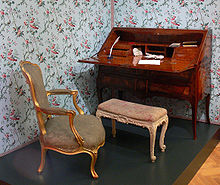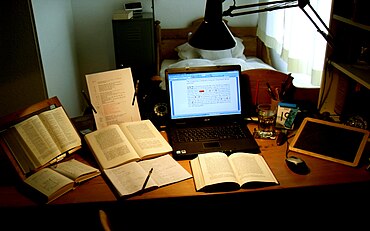writing desk
A desk is a piece of furniture for writing and office work with drawers and compartments for storing paper , files or writing utensils .
history
The Secretary

With a broad interpretation of the term or a functional consideration, the secretary or writing cabinet in the private and the desk (standing desk) of the office office can be regarded as the forerunners of the desk. One variant was the portable desk office and the secretary or writing cabinet . The oldest examples include the desk desks with a chest of drawers as a base and occasionally equipped with a flat top. At the end of the 17th century, the Bureau plat appeared, a relatively long, elegant table with three flat drawers directly under the table top. This desk was complemented by a narrow cabinet next to it, the cartonniere . The cylinder office appeared in the second half of the 18th century , with compartments and drawers behind a roller shutter in a semicircle or quarter circle. After 1760, the cylinder office was one of the most important pieces of furniture in Parisian carpentry. At the same time, there was also the current shape, i.e. the three-part substructure with a flat drawer part in the middle and the side compartments or drawers extending further down.
The secretary and the smaller version for women, the Bonheur du jour , were luxury objects in the 18th and 19th centuries and were mainly common in France. They were placed in private libraries and salons and also served for representation. Normal desks were also available in a smaller form than “women's desks”.
The modern desk
The desk in its current form goes back to the service society, which defined a functional piece of furniture in the workplace. Early examples, such as the tubular steel model by Marcel Breuer for Thonet in the 1920s, already have the one-sided drawer block, but do not correspond to the large dimensions required by office communication devices. For reasons of occupational health and safety for desks used in everyday working life, numerous requirements with regard to size, adjustability in height and type of surface have been defined (e.g. in the VDU Ordinance from 1996). In Japan , for example, some employees think it is important to leave an empty desk at the end of the day.
The various demands on a desk have grown more and more over the years. Not least because of the increasing health awareness of the population, which is causing consumers to increasingly turn to tables that are gentle on their spine and posture. There are more and more different requirements that a modern desk has to meet. In addition to the health aspect, the most important criteria are stability and extra functions. In order to stand out from market competitors, tables with shelf attachments, integrated clipboards or built-in reading lamps are increasingly being produced, which should give the consumer a better working atmosphere.
Manufacturing materials
In past centuries desks were almost exclusively made of solid wood. Since the invention of chipboard , the use of material combinations for desks has been more common. Depending on the requirements, a table frame made of steel or aluminum is built together with a medium-density fibreboard to form a desk. The table tops are also given a melamine resin coating or other finishes to ensure scratch resistance, water resistance and easy cleaning and care.
Height-adjustable desks
Nowadays, due to recent findings in ergonomics, more and more height-adjustable desks are offered. These offer the user the possibility to adjust the working height individually according to the respective needs. The resulting change in posture and stress activates the cardiovascular system and improves blood circulation. Occupational medical and physiological examinations have shown that the various, time-balanced loads reduce posture-related complaints, and also prevent poor concentration and loss of performance. This effect is commonly referred to as the standing-sitting dynamic.
meaning
The desk is often associated with their work, especially by philosophers and writers, regardless of where it was written. The study by Ernst Bloch is open to the public, as well as that of Ernst Jünger . Theodor Adorno's desk is even on public display as a memorial in a glass case in Frankfurt .
Ernst Bloch's study in the Ernst Bloch Center
Adorno monument by Vadim Zakharov in Frankfurt
Writing desk of the writer Ernst Jünger in the Jünger House in Wilflingen
literature
- Meyer's Encyclopedic Lexicon . Volume 21, Bibliographisches Institut, Mannheim / Vienna / Zurich 1973, DNB 921435460 , p. 261.
- Renate Dolz: Furniture Stylistics . Wilhelm Heyne Verlag, Munich 1997, ISBN 3-453-13046-4 .
- Reiner Niehoff: The desk or the double bottom of the font. Radio-Essay, SWR2, June 2015. ( Manuscript )
Individual evidence
- ↑ “When I looked around, my gaze fell on a women's desk near the window with a writing case on it. Immediately afterwards the woman of the house appears. ”From the magazine Uhu from October 1924, p. 111.
- ↑ Standing-sitting dynamics. In: baua.de . Retrieved August 10, 2019.





